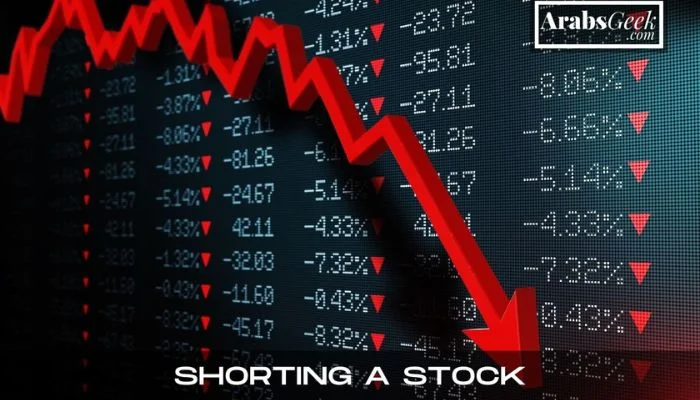Introduction | Shorting a Stock
The stock market can be a roller coaster ride, with prices fluctuating due to a myriad of factors. While most investors aim to buy low and sell high, there’s an alternative strategy that allows investors to potentially profit from falling prices: short selling, or “shorting” a stock. But what does it mean to short a stock, and what are the risks and rewards involved? Let’s delve into this complex yet intriguing aspect of investin
Table of Contents
Understanding Short Selling
What is Short Selling? | Shorting a Stock
Short selling is an investment strategy where an investor borrows shares of a stock from a broker and sells them in the open market, hoping to buy them back later at a lower price. The investor then returns the borrowed shares to the broker, pocketing the difference if the stock price has indeed fallen.
For any business enquiry, you can contact us at ArabsGeek.com
For more of such financial articles, Consider visiting our sister website at EntrepreneursPilot.com
How Does Short Selling Work?
Imagine you believe a particular stock, currently priced at $100, is overvalued and likely to drop in price. You decide to short 10 shares. Your broker lends you the shares, which you promptly sell, receiving $1,000. Later, as expected, the stock price drops to $80. You buy back the 10 shares for $800 and return them to your broker. Your profit, in this case, is $200 (minus any fees or interest charged by the broker).
The Risks of Short Selling
Unlimited Loss Potential
While short selling can be profitable, it’s essential to understand that it carries significant risks. When you buy a stock (go long), your potential loss is capped at the amount you invested – the stock price can’t drop below zero. However, when short selling, your potential loss is theoretically unlimited because there’s no upper limit to how high the stock price can rise.
Short Squeeze | Shorting a Stock
A short squeeze is another risk associated with short selling. This occurs when a heavily shorted stock begins to rise in price, and short sellers scramble to buy shares to cover their positions, further driving up the price. This can lead to rapid and significant losses for short sellers.
Regulatory Risks
Short selling is subject to regulatory scrutiny and can be restricted or banned during turbulent market conditions. This can lead to unexpected losses if short sellers are forced to cover their positions due to regulatory changes.
The Rewards of Short Selling
Profit from Market Downturns
Despite the risks, short selling can be a powerful tool in an investor’s arsenal. One of the primary benefits of short selling is the ability to profit from market downturns. When stocks are overvalued or in a bear market, short sellers can potentially earn substantial profits.
Hedge Against Other Investments
Short selling can also serve as a hedge against other investments. If an investor has a long position in a related stock or sector, shorting a stock can help offset potential losses if the market moves against their long positions.
How to Short a Stock
Choose the Right Broker
Not all brokers allow short selling, so the first step to short a stock is to find a broker that does. It’s also essential to understand the broker’s terms and fees associated with short selling.
Find a Suitable Stock | Shorting a Stock
Once you have a suitable broker, the next step is to identify a stock that you believe is overvalued or likely to drop in price. This can be based on fundamental analysis, technical analysis, or a combination of both.
Initiate the Short Sale
After identifying a suitable stock, you can initiate the short sale through your broker. It’s crucial to monitor the position closely, as you’ll need to cover your short position by buying the stock back at some point in the future.
Short Selling Strategies
Pairs Trading | Shorting a Stock
Pairs trading is a strategy that involves taking a long position and a short position in two related stocks. The idea is to profit from the relative change in price, regardless of the overall market direction.
Technical Analysis
Some short sellers use technical analysis to identify stocks that are likely to drop in price. This could involve looking for patterns or indicators that suggest a stock is overbought or on a downward trend.
Ethical Considerations of Short Selling
Market Manipulation Concerns | Shorting a Stock
Short selling often faces criticism for potential market manipulation. Some people believe that short sellers can spread negative rumors about a company to drive down its stock price. While this is illegal, it can be difficult to prove and regulate.
Impact on Companies
Short selling can also have a direct impact on companies. A falling stock price can make it harder for a company to raise capital and can impact its reputation.
Conclusion | Shorting a Stock
Shorting a stock is a complex strategy that involves substantial risk, but also the potential for significant rewards. It allows investors to profit from falling stock prices and can serve as a hedge against other investments. However, due to the potential for unlimited losses and other risks, it’s not suitable for all investors. Before deciding to short a stock, it’s crucial to fully understand the process, the risks involved, and to consider your individual investment goals and risk tolerance.
Frequently Asked Questions (FAQs)
Q1. Can anyone short a stock?
While anyone with a brokerage account can theoretically short a stock, not all brokers offer this service, and it’s typically recommended only for experienced investors due to the high level of risk involved.
Q2. What happens if the stock price goes up after I short a stock?
If the stock price rises after you short a stock, you could face significant losses. You would need to buy the stock back at a higher price to cover your short position, resulting in a loss equal to the difference in price.
Q3. Can you short a stock and hold it forever?
No, you cannot hold a short position forever. At some point, you must buy back the stock to cover your short position. Additionally, you’ll pay interest on the borrowed shares for the duration of the short position.
Q4. What triggers a short squeeze?
A short squeeze is triggered when a stock’s price starts to rise quickly, and short sellers scramble to cover their positions to prevent further losses. The buying pressure from short sellers covering their positions can drive the price up even further, exacerbating the squeeze.
Q5. What are the ethical considerations of short selling?
There are several ethical considerations associated with short selling. These include potential market manipulation, where short sellers could theoretically spread false information to drive a stock’s price down, and the impact on companies, as a falling stock price can affect a company’s ability to raise capital and its overall reputation.
Remember, while short selling offers the potential for profit in a declining market, it also carries significant risk. Therefore, it should be used judiciously and primarily by those with a thorough understanding of the markets and the associated risks.











